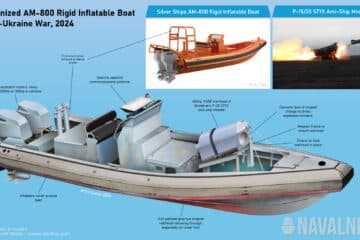Ukraine’s surprising answer to the Russia’s total naval dominance in the Black Sea is a drone. Armed UAVs (uncrewed air vehicles) have become an expected part of land warfare. And thanks to the videos they record, a larger-than-life part of the public’s perception of the modern fighting. But their utility in a naval conflict was, until now, open to speculation.
Ukraine has shown that they are more potent than many analysts would have dared to imagine. The waters near Odesa are being stalked by the Ukraine’s Bayraktar TB2 armed UAV.
The Ukrainian Navy operates late-production TB2s. These can be visually distinguished from the Air Force’s earlier examples by a three-bladed propeller and large cormorant’s head motive on the fuselage. But there are other more subtle differences. The Navy TB2s have an additional infrared camera for night operations. And they appear, based on analysis of photos, to be equipped with a GPS-GNSS Anti-Jammer antenna. This allows it to operate in a contested electronic warfare environment where some other drones might fall out of the sky.
Ukrainian Bayraktars have been observed with two Turkish made weapon systems. The ultra-lightweight MAM-C is a smart micro munition specifically developed for UAVs. Although its cylindrical body and two sets of fins give it a missile appearance, it is actually a laser guided glide bomb. It has a range of 8 km (4.3 nautical miles) and can carry blast fragmentation or armor piercing warheads. The heavier MAM-L has a longer range and larger warhead.
Since the removal of the Russian Navy’s flagship, the Slava Class cruiser Moskva, by Neptune anti-ship missiles on April 13, they have inflicted a significant toll on the Russian Navy. In particular over Snake Island, a small but strategic rock at the southwest tip of Ukraine.
Armed Drones Redefining Warfare
Armed UAVs are playing an ever-increasing role in conflict. The Turkish-made Bayraktar TB2 fits into the category of an armed MALE (medium altitude, long endurance) drone. This space was pioneered and shaped by America’s successful MQ-9 Reaper (aka Predator-B).
The Bayraktar is much smaller than the U.S. designs. It has about half the wingspan of the Reaper and much less than half the payload. It also lacks the satellite communications which give the American system its global reach.
But none of that has stopped the Bayraktar from racking up an impressive combat record. Turkish forces employed them against Kurdish separatists and in Syria. They were then deployed to Libya where they gained a reputation stalking sophisticated Russian air defense systems. Systems like Pantsir are designed to take down drones, but proved vulnerable to the Bayraktar.

Bayraktar: The Ghost Of Snake Island
This plays out in the Black Sea also. The of the Bayraktar TB2’s first documented kill near Snake Island were two Raptor assault boats on May 2. This was followed on May 6 by a Tor (SA-15 GAUNTLET) air defense system on the island itself. This system was perceived to be a drone killer, but the slow moving TB2 turned the tables.
Killing the SA-15 left Russian forces on the island exposed to more air strikes, and the Bayraktar obliged. Buildings were bombed and a TB2 oversaw at least one air raid by Ukrainian Su-27 FLANKER fighters. Most of the buildings on the island were razed, making the barren rock even more bare.
Loitering TB2s proved devastatingly effective at stopping the Russians from replenishing the air defenses on the island. On May 7 one hit a replacement SA-15 while it was still on the landing craft about to be unloaded at the island’s only operable boat ramp. The SA-15’s search radar could be seen scanning even as it was hit.
Russia attempted to reinforce the island by helicopter on May 8. A TB2 was on hand to drop a bomb on a Mi-8 HIP transport helicopter as it unloaded troops. The prominent scorch mark from the wreckage is still visible. 2 more assault boats were also hit in a separate incident near the island.
The Serna Class landing craft hit on May 7 sunk and had to be pulled into deeper water to even partially clear the landing. The Russian navy had to bring in a floating crane and based on the activity witnessed, had to have several attempts. At least two of the large tug boats used had Pantsir air defense units hastily added to their stern decks. Replacement air defense units were eventually landed on May 12, following a complex multi-day effort.

Why Is The Bayraktar So Successful?
The success of mid-sized UAVs like the Bayraktar against leading navies was far from certain. Facing off against the Russian Navy, with its warships armed with sophisticated air defenses, was not the same as operating against terrorists. These drones are, on paper, vulnerable. And their weapons load is limited against warships. But the realities of war have shown otherwise.
Defense analyst Tayfun Ozberk, a retired naval officer, thinks that there are several reasons for this success. Although not fully stealthy, the Bayraktar features a low radar cross-section (RCS). Together with its relatively low altitude and slow speed, this makes it difficult for classical radars to track. “It is a low-slow-flyer (LSF), and you know it is a challenge for classical radars to detect LSFs already. And its RCS makes it even harder.”
Another factor which Ozberk points to is the high level of automation. “The drone is powered with deep learning algorithms, so it becomes better after every missions it conducted.”
The Bayraktar TB2 drone system is modular. Although Russia hit Ukrainian air bases and in the first days of the war, the drones remained operable. Ozberk notes “You can take the drone and flight equipment to a highway, it takes only 15-20 minutes to make it operational”.
Lastly the Bayraktar has proven resilient in a complex electronic warfare environment. Meanwhile Russian ships have been observed minimizing their own radar and electronic signatures by switching equipment off. This is a match made in heaven for the Ukrainian UAV operators.






